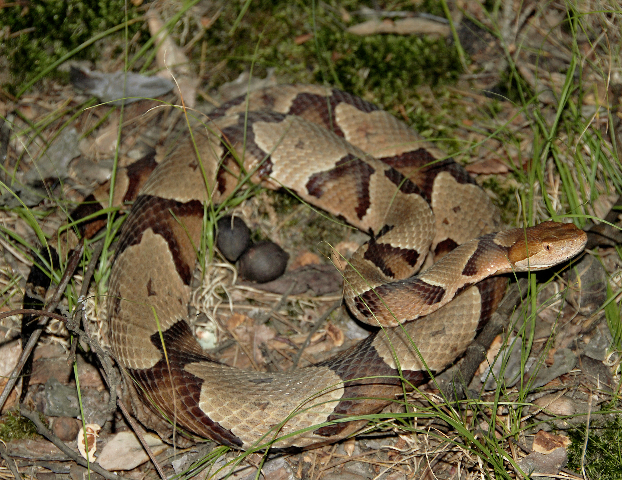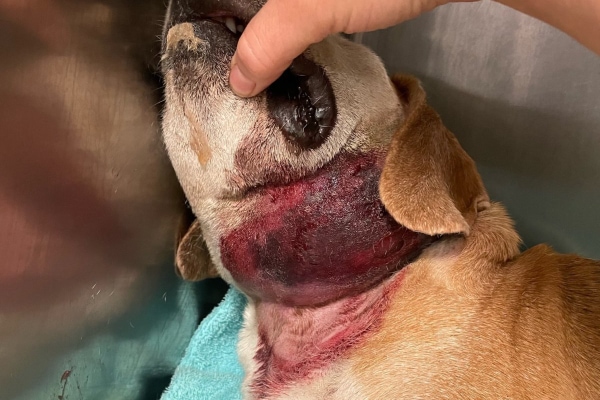Yes, a copperhead bite can be fatal to a dog. Immediate veterinary attention is crucial.
Copperhead snakes are venomous, and their bites can cause severe damage. Dogs are naturally curious and may encounter copperheads during outdoor activities. Copperhead bites are common in certain regions, and knowing the risks is essential for dog owners. The venom from a copperhead can lead to swelling, pain, and more serious health issues.
Quick action can save your pet’s life. Understanding the signs and symptoms of a snake bite can help you respond effectively. In this blog, we will discuss the dangers of copperhead bites, the symptoms to watch for, and the steps to take if your dog is bitten. Stay informed to protect your furry friend.

Credit: www.reddit.com
Introduction To Copperhead Bites
As a dog owner, encountering a snake can be a scary experience. Copperhead snakes are particularly worrisome because of their venomous bites. These snakes are common in many parts of the United States and can be dangerous to pets. But can a copperhead bite kill a dog? Let’s dive into this topic, starting with understanding more about copperhead bites.
Common Habitats
Copperhead snakes thrive in a variety of environments. They are often found in:
- Forests
- Rocky areas
- Swamps
- Near water bodies like streams and rivers
They’re also known to venture into suburban areas, especially where there are plentiful hiding spots like woodpiles, leaf litter, and debris. So, if you live near these habitats, it’s essential to be vigilant when walking your dog.
Behavior And Characteristics
Copperheads are usually non-aggressive and prefer to avoid confrontation. However, they will bite if they feel threatened. Here are some key characteristics to help you identify a copperhead:
| Characteristic | Description |
|---|---|
| Color | Coppery-red head and hourglass-shaped bands on the body |
| Size | Typically 2-3 feet long |
| Habits | Mostly active during the day in spring and fall; nocturnal in summer |
Despite their venomous nature, copperhead bites are rarely fatal to humans. But what about dogs? Dogs, due to their smaller size, can suffer more severe effects from the venom.
Interestingly, dogs often get bitten on the face or legs. A curious nose poking around or an accidental step can lead to an unfortunate encounter. My neighbor’s dog, Bella, once had a close call. She sniffed too close to a copperhead during a hike. Thankfully, with prompt veterinary care, she recovered fully. This underscores the importance of immediate action if your dog is bitten.
So, while a copperhead bite is serious, it doesn’t have to be a death sentence for your furry friend, provided you act quickly and seek professional help.
Recognizing A Copperhead Bite
Dogs are curious by nature, often sniffing around places where danger might lurk. One such danger is the copperhead snake. Recognizing a copperhead bite is crucial in ensuring your furry friend gets the proper care. But how can you identify if your dog has been bitten by one of these venomous snakes?
Symptoms In Dogs
When a copperhead bites, the symptoms in dogs can vary. Here are some common signs you should be aware of:
- Swelling: The bite area will swell up quickly. This is usually the first noticeable symptom.
- Pain: Your dog might yelp or whimper in pain, and the bitten area will be tender to the touch.
- Redness and bruising: The skin around the bite can turn red and bruised.
- Puncture wounds: You might see small puncture marks at the bite site.
- Lethargy: Your dog could become unusually tired and inactive.
- Drooling and vomiting: Some dogs might drool excessively or even vomit.
If you notice any of these symptoms, it’s vital to act quickly and seek veterinary help.
Visual Identification
Identifying a copperhead bite can be tricky, especially if you haven’t seen the snake. However, there are ways to visually identify a copperhead:
- Color and patterns: Copperheads have a distinctive copper-brown color with hourglass-shaped bands across their bodies.
- Size: They typically measure between 2 and 3 feet long, although some can grow larger.
- Head shape: These snakes have a triangular head, which is wider than their necks.
Of course, you shouldn’t get too close to the snake to identify it. Safety first! If you spot a snake that fits this description, it’s best to keep your distance and ensure your dog does the same.
By understanding the symptoms and knowing how to visually identify a copperhead, you can better protect your dog from potential harm. Always keep an eye on your surroundings during walks and hikes, and educate yourself on the local wildlife. Remember, it’s better to be safe than sorry!
Immediate Actions After A Bite
A copperhead bite can be fatal for dogs if not treated quickly. Seek veterinary help immediately and keep the dog calm. Wash the bite area with water and keep it lower than the heart.
So, your dog has been bitten by a copperhead snake. Panic sets in. What should you do next? It’s crucial to act quickly and calmly. This section will guide you through the immediate actions you need to take to ensure your furry friend gets the best possible care.First Aid Steps
First things first, try to stay calm. Your dog can sense your anxiety, which might make them more stressed. Here are some steps you should follow:- Keep your dog still and quiet: Movement can spread the venom faster through their body. Encourage your dog to lie down and stay calm.
- Inspect the bite area: Look for swelling, redness, and two puncture wounds. These signs confirm a snake bite.
- Wash the bite with water: Gently clean the bite area with water to remove any venom on the skin. Do not use soap or alcohol.
- Apply a cold pack: If possible, place a cold pack on the bite area to reduce swelling and pain. Wrap the pack in a cloth to avoid direct contact with the skin.
- Get to the vet immediately: Time is of the essence. Call your vet to let them know you’re coming and head there right away.
What To Avoid
Now, let’s talk about what you should avoid doing. Some actions can actually make things worse for your dog. Here’s a list of things to avoid:- Don’t try to suck out the venom: This old myth can do more harm than good. It won’t help your dog and could expose you to the venom.
- Don’t apply a tourniquet: Cutting off blood flow can cause severe damage to your dog’s limb. It can lead to tissue death and other complications.
- Don’t give your dog painkillers or other medications: Human medications can be toxic to dogs. Always consult your vet before giving any medication.
- Don’t wait to see if symptoms develop: Copperhead bites can be serious. Immediate veterinary care is essential, even if your dog seems fine at first.
Veterinary Treatment Options
When a dog gets bitten by a copperhead, immediate veterinary care is crucial. Timely intervention can make a big difference. Let’s explore the primary veterinary treatment options for a copperhead bite in dogs.
Antivenom
Antivenom is a key treatment option. It neutralizes the venom. Administering antivenom can prevent severe symptoms. Veterinarians often use it to save the dog’s life. The effectiveness depends on the time since the bite. Quick administration increases the chances of recovery. Not all cases require antivenom. The vet decides based on the symptoms and severity.
Supportive Care
Supportive care helps manage symptoms. Hydration is vital. Vets provide intravenous fluids to prevent dehydration. Pain management is also important. They use pain relief medications to keep the dog comfortable. Sometimes, antibiotics are necessary to prevent infections. Monitoring the dog’s vital signs is crucial throughout the treatment. This ensures any changes are addressed promptly.
Potential Complications
If your dog gets bitten by a copperhead, you might be wondering about the possible complications that could arise. While it’s crucial to get your furry friend immediate medical attention, understanding the potential complications can help you take better care of them. Let’s dive into some of these issues, shall we?
Infection Risks
One of the primary concerns after a copperhead bite is the risk of infection. Just like with any wound, a snake bite can get infected if not properly treated. Bacteria from the snake’s mouth or the environment can enter the wound, causing severe issues.
- Redness and swelling
- Pus or fluid discharge
- Fever or lethargy
These symptoms could indicate an infection. It’s essential to keep the bite area clean and follow your vet’s instructions on wound care. Often, antibiotics will be prescribed to prevent or treat infections.
Long-term Effects
In some cases, dogs might experience long-term effects from a copperhead bite. While this is not always the case, it’s good to be aware of what could happen.
- Tissue Damage: The venom can cause significant tissue damage, leading to scarring or even loss of function in severe cases.
- Allergic Reactions: Some dogs could develop an allergy to snake venom, making future bites potentially more dangerous.
- Recurring Pain: Chronic pain or sensitivity at the bite site may persist, causing discomfort for your pet.
Monitoring your dog for any lasting changes in behavior or physical condition is key. Regular check-ups with your vet can help manage any long-term issues that arise.
So, can a copperhead bite kill a dog? While it’s not usually fatal, the complications can be serious. Stay vigilant, seek prompt veterinary care, and follow the advice given by professionals to ensure your dog’s recovery.
And remember, when in doubt, it’s always better to be safe than sorry. After all, our furry friends rely on us to keep them safe and healthy!

Credit: www.petpoisonhelpline.com
Prognosis After A Bite
The prognosis for a dog bitten by a copperhead snake can vary. Several factors influence recovery time and survival rates. Understanding these can help pet owners manage their expectations.
Quick action and proper care can make a significant difference. Let’s explore the key elements that affect recovery and survival.
Factors Influencing Recovery
The size of the dog plays a crucial role in recovery. Smaller dogs are at higher risk due to their size. The location of the bite also matters. Bites on the face or neck are more dangerous.
The amount of venom injected affects the prognosis. Some bites may deliver less venom. The dog’s overall health before the bite is another factor. Healthy dogs tend to recover better.
Immediate veterinary care is vital. Delays can worsen the situation. Antivenom and supportive treatments improve the chances of recovery.
Survival Rates
Survival rates for dogs bitten by copperheads are generally high. Most dogs recover with proper treatment. Studies show a survival rate of over 90%.
Timely intervention is key. Dogs treated within the first few hours have better outcomes. Pet owners should seek veterinary help immediately.
While a copperhead bite is serious, most dogs survive. Awareness and prompt care are essential for a positive prognosis.
Preventing Copperhead Bites
Copperheads are common in many regions and their bites can be dangerous for dogs. While a bite might not always be fatal, it can cause serious pain and complications. Prevention is key. Let’s look at some effective ways to keep your dog safe from these venomous snakes.
Avoiding Snake Habitats
The best way to prevent a copperhead bite is to avoid areas where snakes live. Copperheads are often found in:
- Wooded areas
- Leaf piles
- Rocky areas
- Near water sources
When walking your dog, stay on clear paths and avoid tall grass or underbrush. Sticking to well-trodden trails reduces the risk of an encounter. If you know an area is prone to snakes, it’s best to avoid it altogether. Better safe than sorry, right?
Training Your Dog
Training your dog can also significantly reduce the risk of a copperhead bite. Here are some tips:
- Recall Training: Teach your dog to come back to you immediately when called. This can be a lifesaver if you spot a snake before your dog does.
- Leave It Command: Train your dog to leave things alone when you say “leave it.” This command can prevent your dog from investigating a snake.
- Leash Training: Keep your dog on a leash when walking in areas where snakes might be present. This gives you better control.
Training takes time and patience, but it’s worth it. Imagine the peace of mind you’ll have knowing your dog is less likely to get into a dangerous situation.
In conclusion, by avoiding snake habitats and training your dog, you can significantly reduce the risk of a copperhead bite. Remember, an ounce of prevention is worth a pound of cure. Keep your furry friend safe and enjoy your outdoor adventures without worry.

Credit: toegrips.com
Frequently Asked Questions
Will A Dog Survive A Copperhead Bite?
A dog can survive a copperhead bite with prompt veterinary care. Symptoms include swelling, pain, and lethargy. Seek immediate help.
Should I Give My Dog Benadryl For A Copperhead Bite?
No, do not give your dog Benadryl for a copperhead bite. Seek immediate veterinary care.
Can Dogs Survive A Snake Bite Without Treatment?
Dogs can rarely survive a snake bite without treatment. Immediate veterinary care is crucial for the best outcome.
How Long To Live After A Copperhead Bite?
Most people survive a copperhead bite with prompt medical treatment. Recovery usually takes several weeks. Seek immediate medical help.
Conclusion
While a copperhead bite can be serious, it is rarely fatal for dogs. Quick action and vet care are crucial. Keep your dog safe by staying vigilant. Watch for signs of snake bites. Always seek immediate veterinary help if bitten.
Preventing encounters with copperheads helps keep your dog safe. Being prepared can save your dog’s life. Stay informed and stay safe.